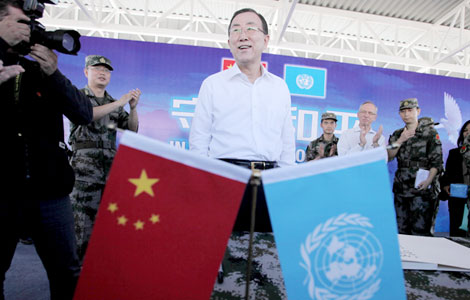Clearing the air
Updated: 2013-06-13 07:06
By Jiang Xueqing in Shijiazhuang, Hebei province, and Wu Wencong in Beijing (China Daily)
|
||||||||
"The current difficulties lie in identifying the responsibilities of each municipality and province to provide a fair base for joint control," he said.
Three State-level meetings have been held to discuss the national air pollution action plan, according to Bao. Consensus has been reached on the measures to take, such as intensifying efforts to control fine particulate matter, greater restrictions on the use of coal, and encouraging increased use of clean energy sources. But questions remain about how consumption should be divided among all the provinces and the target levels for the reduction of emissions in each area.
Although the Beijing municipal government decided to cut the city's coal consumption from 23.3 million tons in 2012 to 15 million tons in 2015, it cannot force other cities and provinces to sacrifice their own economic growth to promote cleaner air in the surrounding areas.
The desire for growth and development has prompted a rapid increase in coal consumption in the areas surrounding Beijing; in 2012, Tianjin burned more than 50 million tons of coal, while Hebei province burned more than 280 million tons.
|
 |
|
A woman wears a face mask in Beijing. WU CHANGQING FOR CHINA DAILY |
"Fundamental changes will not occur if Beijing is the only one to cut coal consumption," said Zhuang.
To prevent regional collaboration from existing in name only, officials in Beijing have appealed to the State Council to lead the collaborative efforts.
Recently, a State Council deputy secretary led a number of relevant government departments - including the Ministry of Environmental Protection, the Ministry of Finance, the National Development and Reform Commission and the Ministry of Transport - in enacting policies for regional collaboration. The official also asked the mayors of Beijing and Tianjin and the governors of Hebei and Shanxi provinces for their thoughts on the problem, according to Zhuang.
Yang Guozhan, deputy secretary-general of Hebei's provincial government, also suggested that a comprehensive central government department should lead the coordination of regional collaboration and formulate specific measures based on the different situations in cities and provinces.
"The choice between economic development and environmental improvement is a dilemma, but we have to strike a balance between the two and resolve to change our economic structure, which relies on excessive consumption of resources and a high level of emissions," said Yang.
He said he hoped the central government would support Hebei, while optimizing the structures of emerging and major industries.
Hard times for Hebei
|
New targets implemented by Jiang Xueqing Sulfur dioxide emissions in China amounted to 21.18 million metric tons in 2012, a fall of 4.52 percent from the previous year, while nitrogen oxide emissions totaled 23.38 million tons, a decline of 2.77 percent, according to a report released by the Ministry of Environmental Protection this month. In September, the State Council approved the Plan on the Prevention and Control of Air Pollution in Key Regions (2011-15). The plan, which covers 117 cities in 19 provinces, implemented targets to reduce the annual mean concentration of PM10 and sulfur dioxide by 10 percent each, nitrogen dioxide by 7 percent and PM2.5 by 5 percent. To support the renovation of coal-fired boilers in 15 cities, the central government provided 1.09 billion yuan ($178 million) in subsidies in 2012. The air quality in those cities has improved significantly since the project was launched, according to the report. Meanwhile, in February 2012 the Ministry of Environmental Protection released revised standards for ambient air quality. The latest standards added several new items, including an annual mean concentration limit and a 24-hour average concentration limit for PM2.5. In all, 496 national air monitoring sites in 74 cities have released real-time data about six basic pollutants, including PM2.5, ozone and sulfur dioxide, since Jan 1. |
For example, by 2017, Shijiazhuang Iron & Steel Co will move from Shijiazhuang, the capital of Hebei, to Huanghua, a county-level city in the Bohai Bay coastal region. The relocation, plus the technological and equipment upgrades, will cost 30 billion yuan, said Yin Guangping, deputy director of Hebei environmental protection bureau.
Although economic growth has slowed in the province this year, development still remains a top priority. The provincial government has demanded that Shijiazhuang increase its GDP from 450 billion yuan in 2012 to 1,000 billion yuan in 2017. At the same time, the city will also need to control the growth in coal consumption to promote improvements in air quality. In 2012 alone, it burned 61 million tons of coal.
"Under normal conditions, the amount of coal consumed in Shijiazhuang will increase by 4 million tons per year. Even if we were to implement all the energy-saving measures, we will still see an increase of 2 million tons. Restraining this increase in consumption is the most difficult task we face right now," said Jia Dongxu, director of the energy office of Shijiazhuang Reform and Development Commission.
Officials in Hebei are also concerned about ensuring sufficient supplies of natural gas - especially during the winter heating season - once coal-fired power plants have been converted to natural gas.
"While we are making a contribution to the joint regional prevention and control of air pollution, we hope the State Council will support us during the collaborative process. For example, could the central government allocate more natural gas to Hebei province?" said Wang Shaohua, vice-mayor of Shijiazhuang.
Once natural gas replaces coal, the costs of manufacturing and heating will increase significantly. In Shijiazhuang, the price of heating 1 square meter will rise from 22 yuan in 2012 to around 38 yuan, according to estimates from local gas companies. Because the city still lags behind in terms of economic development, Wang called for subsidies and preferential tax policies from the Ministry of Finance.
While the cities and provinces surrounding Beijing have emphasized the challenges they face and the sacrifices they are making to control air pollution, some environmental scientists have noted that they will also benefit from regional collaboration.
"People in Hebei province have the right to economic development, it's just as important as their right to breathe clean air. The province is solving air pollution not just for Beijing, but for itself," said Chai.
During the heavy smog and haze that blanketed large parts of China for weeks in January, many cities in Hebei had much worse air quality than Beijing. Also, cities in the province are always on a list of the top 10 most-polluted cities which is released by the Ministry of Environmental Protection on a monthly basis.
"Rather than saying Beijing needs Hebei's help to maintain good air quality, it's fairer to say that keeping the air clean for the people living in the region, including Tianjin and Hebei province, will require efforts from all sides," said Chai.
Contact the writer at jiangxueqing@chinadaily.com.cn

 Michelle lays roses at site along Berlin Wall
Michelle lays roses at site along Berlin Wall
 Historic space lecture in Tiangong-1 commences
Historic space lecture in Tiangong-1 commences
 'Sopranos' Star James Gandolfini dead at 51
'Sopranos' Star James Gandolfini dead at 51
 UN: Number of refugees hits 18-year high
UN: Number of refugees hits 18-year high
 Slide: Jet exercises from aircraft carrier
Slide: Jet exercises from aircraft carrier
 Talks establish fishery hotline
Talks establish fishery hotline
 Foreign buyers eye Chinese drones
Foreign buyers eye Chinese drones
 UN chief hails China's peacekeepers
UN chief hails China's peacekeepers
Most Viewed
Editor's Picks

|

|

|

|

|

|
Today's Top News
Shenzhou X astronaut gives lecture today
US told to reassess duties on Chinese paper
Chinese seek greater share of satellite market
Russia rejects Obama's nuke cut proposal
US immigration bill sees Senate breakthrough
Brazilian cities revoke fare hikes
Moody's warns on China's local govt debt
Air quality in major cities drops in May
US Weekly

|

|







